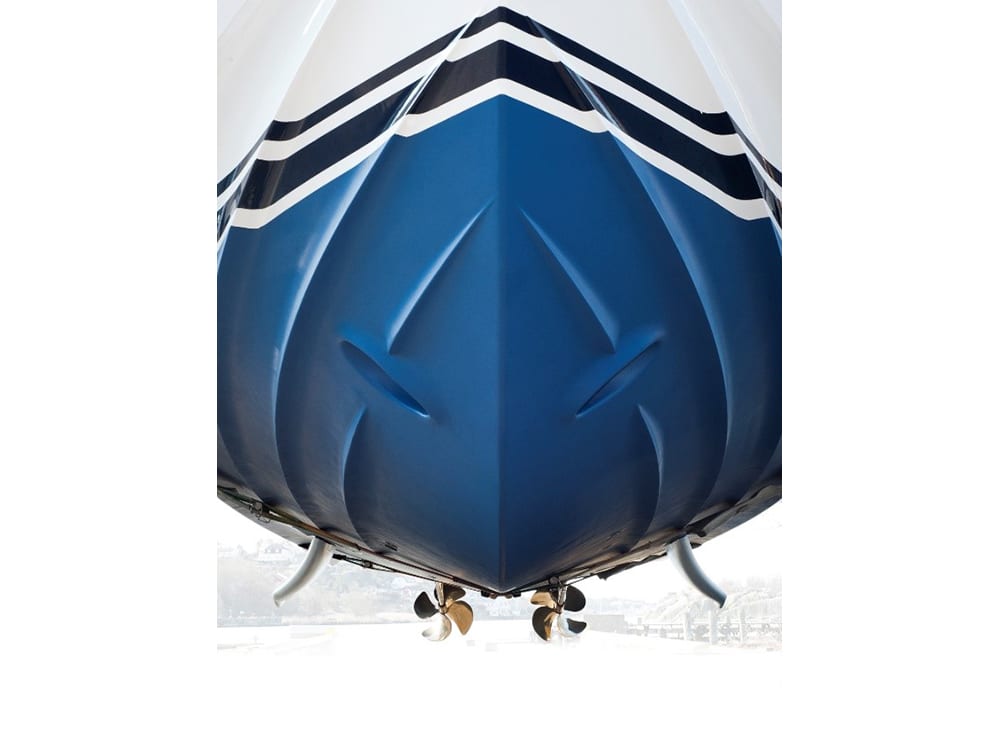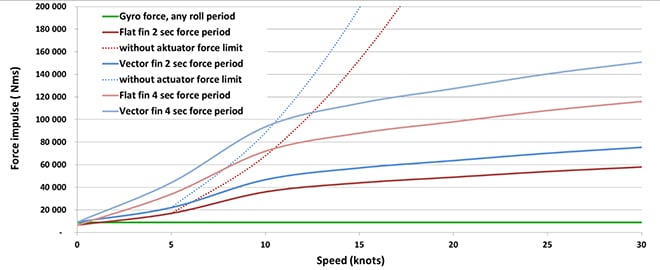
Most owners want to reduce the motion that makes people seasick on their boat, and many have heard about stabilization systems provided by fin stabilizers and gyros. But which is better? And specifically, how do advanced curved-fin systems like Side-Power Vector Fins match up with the most popular gyro systems? Let’s start with the basics and go from there.
Both Vector Fins and gyro systems work well at anchor, assuming you’ve sized the equipment properly. Underway, Vector Fins are usually superior to a gyro because
- the power of the fins increases exponentially with speed;
- the fins can maintain anti-roll force indefinitely while the gyro relies on precession (change in the angle of the gyro’s axis; once the gyro reaches the end of its stroke (or “throw”), the gyro loses its ability to stabilize;
- the fins will also correct list against a steady crosswind while the gyro will quickly run out of precession;
- Vector fins generate significant lift at speed which improves speed and fuel economy over straight fins,
- when a boat goes into a turn, a gyro or straight-fin system will try to keep it level, while the Vector fin system recognizes the difference between a roll and a turn, and banks the boat into the turn to resist the centrifugal force generated. It’s the same sort of effect a banked turn on a race track creates. As a result, with Vector Fins, one barely notices that the boat is turning, and glasses and plates stay put, rather than slide off the table.
Advantages of gyros are that they have no appendage, they are relatively small and compact, and they are well-engineered to minimize the intense heat generated on the bearings by the spinning mass. Gyros come in an attractive package and work well in many circumstances.
Disadvantages of the gyro systems are that they are less effective underway, are heavy, and in some cases, servicing requires removing the unit from the boat. For a 30-knot boat, a gyro must be much bigger–perhaps bigger than space allows–to equal Vector Fins’ performance, so sometimes multiple gyros will be installed. The systems can take up to an hour to “spin up” before they provide full stabilization, also generate noise, may require structural reinforcement, and with few exceptions are wholly dependent on AC power off a generator. In certain sea conditions, their effectiveness is also limited by stroke or precession distance, and when it’s time to replace the main bearings, most gyros must be removed from the boat and returned to the factory for service.

Advantages of Vector Fin stabilizers include the fact that their power increases with speed exponentially and that they generate lift as well as stability, which negates the effect of drag (unlike straight fins). Vector Fins also provide both at-rest and underway stabilization, allow you to bank into turns, and reduce unwanted motions of sway and yaw by up to 30 to 50 percent compared to straight fins. They counteract crosswinds and list, are lighter than gyros by thousands of pounds (depending on size) and allow maintenance of bearings and cylinders to be done in place. Those using hydraulic power can typically use a PTO (power take-off) hydraulic pump on the boat’s engine to get free power underway (it uses AC from a genset or shorepower at rest). An accumulator in the system means less noise and instant response. In fact, the system is virtually silent. The stabilizing force of Vector Fins is directed more vertically than straight fins, increasing efficiency and lift; you can therefore use smaller fins for the same power or larger fins to gain 30 to 50 percent more power than straight fins.

Disadvantages of all fins include the fact that they are appendages and can therefore cause entanglement or be damaged. They create drag, which may be offset by gains in fuel efficiency and speed in the case of Vector Fins. They can also cause sway and yaw, and at anchor they are limited by the length of the fin’s stroke. Also, they need to be positioned roughly in middle of boat so when retrofitting an older boat this may sometimes pose a challenge. Their location also requires ample structure and support for the loads generated. Having said that, a gyro similarly requires significant structural reinforcement and presents similar space challenges.
From a cost standpoint, a detailed analysis of expectations, requirements, and each boat’s suitability should be undertaken by the installer doing the work, but all else being equal, Vector Fins may be equal to or possibly a little less than a gyro installation. There are many factors that will dictate higher and lower costs—for example structural refits needed to add a gyro sometimes make a big difference. Another factor is whether there is space to install either system, and/or what existing equipment will need to be moved in order to create the space for a gyro or fin system.
One of the greatest variables in any stabilization decision is the owner’s expectations. What’s most important? Stabilization at any speed, or optimizing for at-rest performance? If at-rest stabilization is the priority, a smaller gyro will cost less than one that is two or three times the size, which may be what is required for any-speed stabilization. For any-speed stabilization, the equipment cost of a Vector Fin system would be significantly less than a gyro system. We know of boats on which a second and even a third gyro have been added to get satisfactory stabilization; for these boats, a Side-Power Vector fin system would have cost far less.









